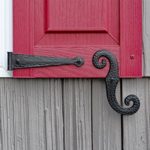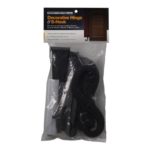- Strap Hinge (4)
1-3/4″ x 7-1/4″
- Shutter Dogs (2)
2-3/4″ x 6-3/4″
- Screws (10)
1-1/8″
Faux Shutter Hardware
Description
Faux vinyl shutter hardware is only sold in conjunction with vinyl exterior shutters.
Faux shutter hardware for vinyl shutters simulates the appearance of authentic cast iron functional hinges and tiebacks. Each packet includes four faux strap hinges and two S-pattern shutter dogs (enough for one pair of exterior shutters). The decorative embellishments are not functional and are not for operable shutter installation. Some may refer to this product as fake or false hardware.
Price: $20 per packet
Item Added to Cart
- Price
$14 per packet
- Material
Polypropylene
Pre-colored, not paintable
Hammered textured surface - Colors
Black #002
Gray #007
Screws match hardware - Packet Includes
4 Strap hinge faceplates
2 Shutter dog faceplates
10 Screws
(enough for one pair of shutters) - Installation
- Availability
Sold only in conjunction
with vinyl shutters –
not as a standalone item
Not returnable

Straight Top Shutters
Straight top shutters are manufactured with a square horizontal top.
Rail sizes are displayed in the “Dimensions” area on the main order page.

Arch Top Shutters
More about arch top shuttersArch top shutters are made with a curved top.
The specified shutter height is the dimension of the long vertical edge of the shutter.
The required springline is the measurement from the top of the shutter down to the start of the arch.
A divider rail is a horizontal bar (much like the top rail) that creates louver areas above and below the division. The divider rail height is 2 ½” on front and back and rabbeted to reduce gap between rail and louvers.

No Divider Rail
- Configuration allowable when the shutter is shorter than 90″
- The “No” divider rail button becomes unavailable on the order page when height is greater than or equal to 90″

One Divider Rail
- Measure from the bottom of the shutter to the desired center of the divider rail*
- Optional when the shutter is shorter than 90″
- Required if height is greater than or equal to 90″
- Divider rail size is displayed under “Specifications” on the main order page
* The actual location of the divider rail may be slightly higher or lower than requested. The number of louvers will dictate the final placement.

Two Divider Rails
- Measure from the bottom of the shutter to the desired center of the first divider rail*
- Then, measure from the bottom of the shutter to the desired center of the second divider rail*
- Divider rail size is displayed under “Specifications” on the main order page
* The actual location of the divider rails may be slightly higher or lower than requested. The number of louvers will dictate the final placement.
A divider rail is a horizontal bar (much like the top rail) that creates louver areas above and below the division. The divider rail height is 3″ for 1.75″ 1.5″ louvers.

No Divider Rail
- Configuration allowable when the shutter is shorter than 90″
- The “No” divider rail button becomes unavailable on the order page when height is greater than or equal to 90″

One Divider Rail
- Measure from the bottom of the shutter to the desired center of the divider rail*
- Optional when the shutter is shorter than 90″
- Required if height is greater than or equal to 90″
- Divider rail size is displayed under “Specifications” on the main order page
* The actual location of the divider rail may be slightly higher or lower than requested. The number of louvers will dictate the final placement.

Two Divider Rails
- Measure from the bottom of the shutter to the desired center of the first divider rail*
- Then, measure from the bottom of the shutter to the desired center of the second divider rail*
- Divider rail size is displayed under “Specifications” on the main order page
* The actual location of the divider rails may be slightly higher or lower than requested. The number of louvers will dictate the final placement.
A divider rail is a horizontal bar (much like the top rail) that creates louver areas above and below the division. The divider rail height is 3.5″ for 1.75″ louvers and 3″ for 1.5″ louvers.

No Divider Rail
- Configuration allowable when the shutter is shorter than 90″
- The “No” divider rail button becomes unavailable on the order page when height is greater than or equal to 90″

One Divider Rail
- Measure from the bottom of the shutter to the desired center of the divider rail*
- Optional when the shutter is shorter than 90″
- Required if height is greater than or equal to 90″
- Divider rail size is displayed under “Specifications” on the main order page
* The actual location of the divider rail may be slightly higher or lower than requested. The number of louvers will dictate the final placement.

Two Divider Rails
- Measure from the bottom of the shutter to the desired center of the first divider rail*
- Then, measure from the bottom of the shutter to the desired center of the second divider rail*
- Divider rail size is displayed under “Specifications” on the main order page
* The actual location of the divider rails may be slightly higher or lower than requested. The number of louvers will dictate the final placement.
Measure PVC Shutters
PVC exterior shutters install to the side of the window using one of two methods.
Stationary shutters permanently attach to the side of the window in a fixed location with the included polycarbonate mounting brackets.
Functional shutters mount with operable exterior hardware to pivot from a position flanking the window to cover the window opening.
How the window is measured depends on which of these two options is selected.
Measure Wood Shutters
Wood exterior shutters install to the side of the window using one of two methods.
Stationary shutters permanently attach to the side of the window in a fixed location.
Functional shutters mount with operable exterior hardware to pivot from a position flanking the window to cover the window opening.
How the window is measured depends on which of these two options is selected.

1.75" Louvers (Standard)
- 1.75″ wide
- 0.25″ thick
- Length 4.25″ less than shutter width
- Spaced on 1.75″ centers
- 0.1875″ between louvers
- Fixed 17° angle – do not rotate
- Number of louvers determined by shutter height
Return to order page to calculate in “Specifications” section

1.5" Louvers
- 1.5″ wide
- 0.25″ thick
- Length 4.25″ less than shutter width
- Spaced on 1.5″ centers
- 0.1875″ between louvers
- Fixed 17° angle – do not rotate
- Number of louvers determined by shutter height
Return to order page to calculate in “Specifications” section - Adds $25 per shutter
ShutterLand’s manufacturing process has been streamlined to keep costs and manufacturing time at a minimum. Therefore, we do not deviate from these two louver sizes.

Faux Tilt Bar
A tilt bar is a narrow vertical wood rod that interconnects a group of horizontal louvers. A tilt bar used in conjunction with movable louvers unifies the slats and allows them to rotate at one time. Louvers on ShutterLand premium wood louvers are fixed in position and do not rotate. A faux tilt bar can be attached to replicate the appearance of movable louvers, usually for historical purposes. Selection of a tilt bar adds $40 to the price of each shutter.
Most exterior shutter applications do not require a tilt bar.

Faux Tilt Bar - Shutter With a Divider Rail
If a divider rail is employed, the tilt bar can be added to all louver sections or only added to one section.
After incorporating a tilt bar, it is necessary to establish if the tilt bar will be applied to all louvers and if the louvers will be in an up or down position.

Faux Tilt Bar - Louvers Down
The tilt bar can be attached on the side of the shutter with the louvers in a down position.

Faux Tilt Bar - Louvers Up
The tilt bar can be attached on the side of the shutter with the louvers in an up position.

Tilt Bar
A tilt bar is a narrow vertical wood rod that interconnects a group of horizontal louvers. A tilt bar used in conjunction with movable louvers unifies the slats and allows them to rotate at one time. Louvers on ShutterLand wood louvers are fixed in position and do not rotate. A faux tilt bar can be attached to replicate the appearance of movable louvers, usually for historical purposes. Selection of a tilt bar adds $40 to the price of each shutter.
Most exterior shutter applications do not require a tilt bar.
If a divider rail is employed, the tilt bar can be added to all louver sections or only added to one section.
After incorporating a tilt bar, it is necessary to establish if the tilt bar will be applied to all louvers and if the louvers will be in an up or down position.

Faux Tilt Bar - Louvers Down
The tilt bar can be attached on the side of the shutter with the louvers in a down position.

Faux Tilt Bar - Louvers Up
The tilt bar can be attached on the side of the shutter with the louvers in an up position.

Pine Wood Louvers
- 1.75″ wide
- 0.25″ thick
- Length 4.25″ less than shutter width
- Spaced on 1.75″ centers
- 0.1875″ between louvers
- Fixed 17° angle – do not rotate
- Number of louvers determined by shutter height
Return to order page to calculate in “Specifications” section
ShutterLand’s manufacturing process has been streamlined to keep costs and manufacturing time at a minimum. Therefore, we do not deviate from this louver size.

Southern Yellow Pine
Read moreSouthern Yellow Pine is the most affordable solid wood option. This wood has a beautiful golden color with a distinct wood grain pattern that is 99.9% knot free. It is kiln-dried to minimum moisture content and cut to 1″ thick shutters. The joints between stiles and rails are glued, doweled, and screwed for ultimate strength.
Southern Yellow Pine shutters are considered entry-level, or builder grade, with lower performance standards compared to 1.5″ thick premium wood shutters.
Measure Composite Shutters
Composite exterior shutters install in a stationary position to the side of the window with the included Lexan polycarbonate fixed mounting brackets.
The v-shaped 1-1/8″ x 1-1/8″ brackets are specifically suited for use with outdoor composite shutters. The vertical side of the bracket attaches to the building and the horizontal side to the top or bottom of the shutter. The brackets extend the full width of the shutter and are not easily visible after installation.

1.75" Composite Louvers (Standard)
- 1.75″ visible surface area (see illustration)
- Length 5″ less than shutter width
- Louver sections made in one piece (not separate, individual louvers)
- No space between louvers
- Fixed down at 10° angle
- Number of louvers determined by shutter height
Return to order page to calculate in “Specifications” section

1" Composite Louvers
- 1″ visible surface area (see illustration)
- Length 5″ less than shutter width
- Louver sections made in one piece (not separate, individual louvers)
- No space between louvers
- Fixed down at 20° angle
- Number of louvers determined by shutter height
Return to order page to calculate in “Specifications” section - Adds $15 per shutter
ShutterLand’s manufacturing process has been streamlined to keep costs and manufacturing time at a minimum. Therefore, we do not deviate from these two louver sizes.

Faux Tilt Bar
A tilt bar is a narrow vertical wood rod that interconnects a group of horizontal louvers. Historically, a tilt bar unifies a group of movable louvers to allow them to rotate at one time. ShutterLand composite louvers are fixed in a downward-pointing position and do NOT rotate. A faux tilt bar can be attached to replicate the appearance of movable louvers, usually for historical purposes. Selection of a tilt bar adds $40 to the price of each shutter.
Most exterior shutter applications do not require a tilt bar.

Composite Shutters
Read moreShutterLand composite shutters are constructed from Extira. The material is manufactured from sustainable wood fibers and marine-grade resins to form large 1.25″ thick solid straight sheets. Individual components are then milled and fabricated into custom shutters. Extira is designed for outdoor applications where humidity and moisture varies. It is strong and resilient with a long projected life.

Unfinished - Paint Grade
Unfinished shutters are raw with no finish applied. Small blemishes may be repaired with wood filler, which will arrive sanded smooth and ready to finish. Filled areas will not diminish the integrity of the shutter or show through the paint. The PVC stiles and rails do not require priming for paint adhesion. The central solid panels are constructed from composite and do need to be primed before painting.

Standard Paint Colors
Select from 9 standard paint colors. Painted exterior shutters are sprayed with two ultra-durable, water-borne commercial-grade Benjamin Moore Corotech COMMAND acrylic top coats. The factory applied paint covers all surfaces in a smooth satin sheen finish.

Custom Paint Colors
Choose a custom paint color for a one-time amount of $200 to match the color (NOT per shutter). Provide the paint manufacturer, color name, and color code to match. Or a color chip or physical sample may be mailed to match.
Painted PVC exterior shutters are lightly sanded and sprayed with two ultra-durable, water-borne commercial-grade Benjamin Moore Corotech COMMAND acrylic top coats. The factory applied paint covers all surfaces in a smooth satin sheen finish. The paint manufacturer specifically instructs that PVC shutters not be primed in preparation for application of paint.

Unfinished - Paint Grade
Unfinished shutters are raw with no finish applied. Small blemishes may be repaired with wood filler, which will arrive sanded smooth and ready to finish. Filled areas will not diminish the integrity of the shutter or show through the paint. PVC shutters do not require priming and it is not necessary for paint adhesion.

Standard Paint Colors
Select from 9 standard paint colors. Painted exterior shutters are sprayed with two ultra-durable, water-borne commercial-grade Benjamin Moore Corotech COMMAND acrylic top coats. The factory applied paint covers all surfaces in a smooth satin sheen finish.

Custom Paint Colors
Choose a custom paint color for a one-time amount of $200 to match the color (NOT per shutter). Provide the paint manufacturer, color name, and color code to match. Or a color chip or physical sample may be mailed to match.
Painted PVC exterior shutters are lightly sanded and sprayed with two ultra-durable, water-borne commercial-grade Benjamin Moore Corotech COMMAND acrylic top coats. The factory applied paint covers all surfaces in a smooth satin sheen finish. The paint manufacturer specifically instructs that PVC shutters not be primed in preparation for application of paint.

Unfinished - Paint Grade
Unfinished shutters are raw with no finish applied. All surfaces are sanded. Small blemishes are repaired with wood filler, which will arrive sanded smooth and ready to finish. Filled areas will not diminish the integrity of the shutter or show through the paint. Priming is recommended to seal the grain and support paint adhesion.

Unfinished - Stain Grade
Unfinished shutters are raw with no finish applied. All surfaces are thoroughly sanded. Wood is selected for a relatively uniform grain. Minor blemishes (if any) are repaired with stainable wood filler, which will arrive sanded smooth and ready to finish. Filled areas will not diminish the integrity or appearance of the shutter.

Primed
Primed shutters are sprayed with Benjamin Moore Aqua Lock Plus acrylic water-based universal primer / sealer. This primer provides complete coverage to seal the porous raw surface, block stains and prevent bleed-through. The medium gray primed surface will need to be sanded with 220 grit sandpaper and wiped clear of dust before painting.

Standard Paint Colors
Select from 9 standard paint colors. Painted exterior shutters are sanded, primed, sanded, and sprayed with two ultra-durable, water-borne commercial-grade Benjamin Moore Corotech COMMAND acrylic top coats. The factory applied paint covers all surfaces in a smooth satin sheen finish.

Custom Paint Colors
Read moreChoose a custom paint color for a one-time amount of $200 to match the color (NOT per shutter). Provide the paint manufacturer, color name, and color code to match. Or a color chip or physical sample may be mailed to match.
Painted exterior shutters are sanded, primed, sanded, and sprayed with two ultra-durable, water-borne commercial-grade Benjamin Moore Corotech COMMAND acrylic top coats. The factory applied paint covers all surfaces in a smooth satin sheen finish.

Straight Top Shutters
Straight top shutters are manufactured with a square horizontal top.
Rail sizes are displayed in the “Dimensions” area on the main order page.

Arch Top Shutters
More about arch top shuttersArch top shutters are made with a curved top.
The specified shutter height is the dimension of the long vertical edge of the shutter.
The required springline is the measurement from the top of the shutter down to the start of the arch.

Raised Panel
Crafted with a ⅝” thick central plateau surrounded by a 1 ⅛” wide bevel
Flat on back of shutterMaterial: Extira composite

Flat Panel
Made with a flat ⅝” thick interior panel
Flat on back of shutterMaterial: Extira composite

Shaker Panel
Made with a flat ⅝” thick interior panel with grooves cut to simulate vertical boards.
Shutter width:
2 grooves: 14” to 17 ¾”
3 grooves: 18” to 23 ¾”
4 grooves: 24” to 31 ¾”
5 grooves: 32” to 39 ¾”
6 grooves: 40” to 45”
Flat on back of shutterMaterial: Extira composite
A divider rail is a horizontal bar (much like the top rail) that creates raised panel areas above and below the division.

No Divider Rail
Solid panel with no divider rail

One Divider Rail
Solid panel with one divider rail
Measure from the bottom of the shutter to the desired center of the divider rail
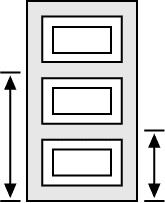
Two Divider Rails
Solid panel with two divider rails
Measure from the bottom of the shutter to the desired center of the first divider rail
Then, measure from the bottom of the shutter to the desired center of the second divider rail
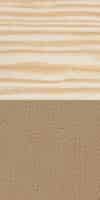
Unfinished - Paint Grade
Unfinished shutters are raw with no finish applied. All surfaces are thoroughly sanded. Small blemishes are repaired with wood filler, which will arrive sanded smooth and ready to finish. Filled areas will not diminish the integrity of the shutter or show through the paint. Priming is recommended to seal the grain and support paint adhesion. Solid panel areas are composite and cannot be stained.

Primed
Primed shutters are sprayed with Benjamin Moore Aqua Lock Plus acrylic water-based universal primer / sealer. This primer provides complete coverage to seal the porous raw surface, block stains and prevent bleed-through. The medium gray primed surface will need to be sanded with 220 grit sandpaper and wiped clear of dust before painting.

Standard Paint Colors
Select from 9 standard paint colors. Painted exterior shutters are sanded, primed, sanded, and sprayed with two ultra-durable, water-borne commercial-grade Benjamin Moore Corotech COMMAND acrylic top coats. The factory applied paint covers all surfaces in a smooth satin sheen finish.

Custom Paint Colors
Read MoreChoose a custom paint color for a one-time amount of $200 to match the color (NOT per shutter). Provide the paint manufacturer, color name, and color code to match. Or a color chip or physical sample may be mailed to match.
Painted exterior shutters are sanded, primed, sanded, and sprayed with two ultra-durable, water-borne commercial-grade Benjamin Moore Corotech COMMAND acrylic top coats. The factory applied paint covers all surfaces in a smooth satin sheen finish.

Unfinished - Paint Grade
Unfinished shutters are raw with no finish applied. All surfaces are thoroughly sanded. Small blemishes are repaired with wood filler, which will arrive sanded smooth and ready to finish. Filled areas will not diminish the integrity of the shutter or show through the paint. Priming is recommended to seal the grain and support paint adhesion. Solid panel areas are composite and cannot be stained.

Primed
Primed shutters are sprayed with Benjamin Moore Aqua Lock Plus acrylic water-based universal primer / sealer. This primer provides complete coverage to seal the porous raw surface, block stains and prevent bleed-through. The medium gray primed surface will need to be sanded with 220 grit sandpaper and wiped clear of dust before painting.

Standard Paint Colors
Select from 9 standard paint colors. Painted exterior shutters are sanded, primed, sanded, and sprayed with two ultra-durable, water-borne commercial-grade Benjamin Moore Corotech COMMAND acrylic top coats. The factory applied paint covers all surfaces in a smooth satin sheen finish.

Custom Paint Colors
Read moreChoose a custom paint color for a one-time amount of $200 to match the color (NOT per shutter). Provide the paint manufacturer, color name, and color code to match. Or a color chip or physical sample may be mailed to match.
Painted exterior shutters are sanded, primed, sanded, and sprayed with two ultra-durable, water-borne commercial-grade Benjamin Moore Corotech COMMAND acrylic top coats. The factory applied paint covers all surfaces in a smooth satin sheen finish.

Unfinished - Paint Grade
Unfinished shutters are raw with no finish applied. All surfaces are sanded, ready to be primed. Priming is recommended to seal the material and support paint adhesion. Extira composite cannot be stained.

Primed
Primed shutters are sprayed with Benjamin Moore Aqua Lock Plus acrylic water-based universal primer / sealer. This primer provides complete coverage to seal the porous raw surface and block stains. The medium gray primed surface will need to be sanded with 220 grit sandpaper and wiped clear of dust before painting.

Standard Paint Colors
Select from 9 standard paint colors. Painted exterior shutters are sanded, primed, sanded, and sprayed with two ultra-durable, water-borne commercial-grade Benjamin Moore Corotech COMMAND acrylic top coats. The factory applied paint covers all surfaces in a satin sheen finish.

Custom Paint Colors
Read moreChoose a custom paint color for a one-time amount of $200 to match the color (NOT per shutter). Provide the paint manufacturer, color name, and color code to match. Or a color chip or physical sample may be mailed to match.
Painted exterior shutters are sanded, primed, sanded, and sprayed with two ultra-durable, water-borne commercial-grade Benjamin Moore Corotech COMMAND acrylic top coats. The factory applied paint covers all surfaces in a smooth satin sheen finish.
Standard Paint Colors
Select from 9 standard paint colors plus an unlimited selection of custom colors.
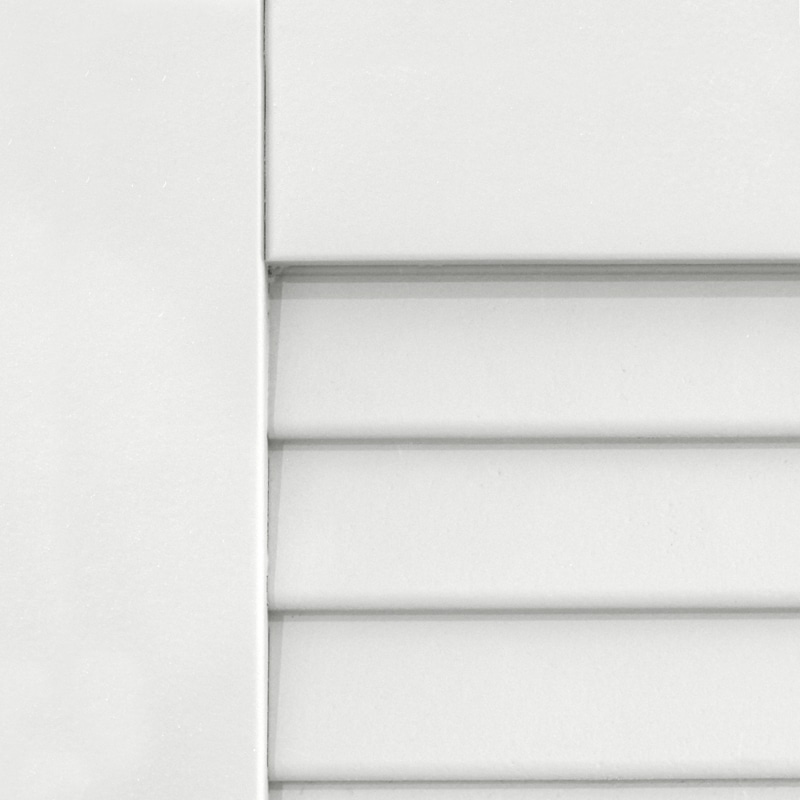 White
White Charcoal Slate
Charcoal Slate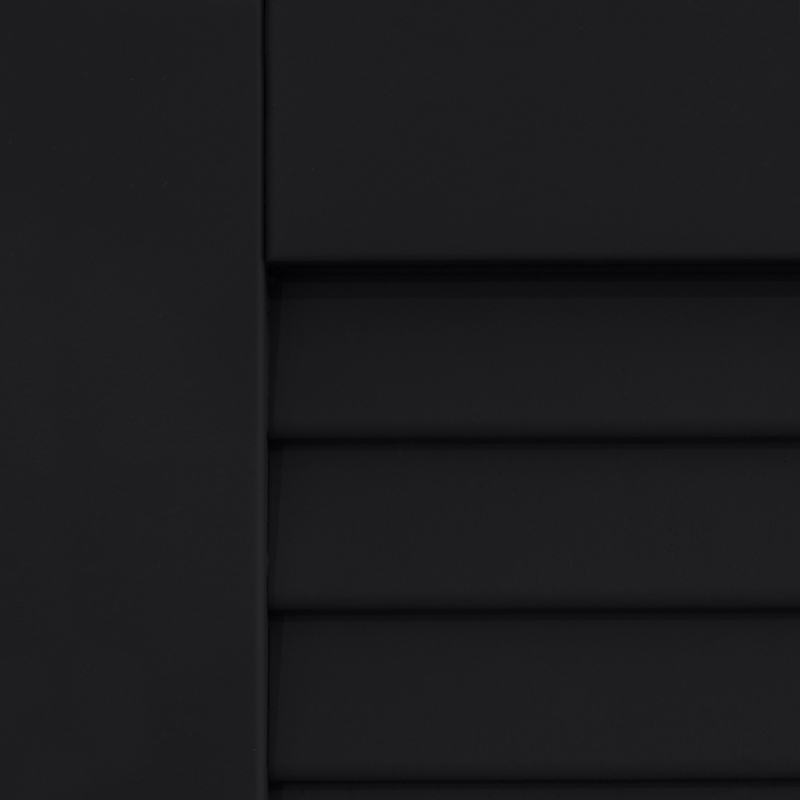 Black
Black Black Forest Green
Black Forest Green Chrome Green
Chrome Green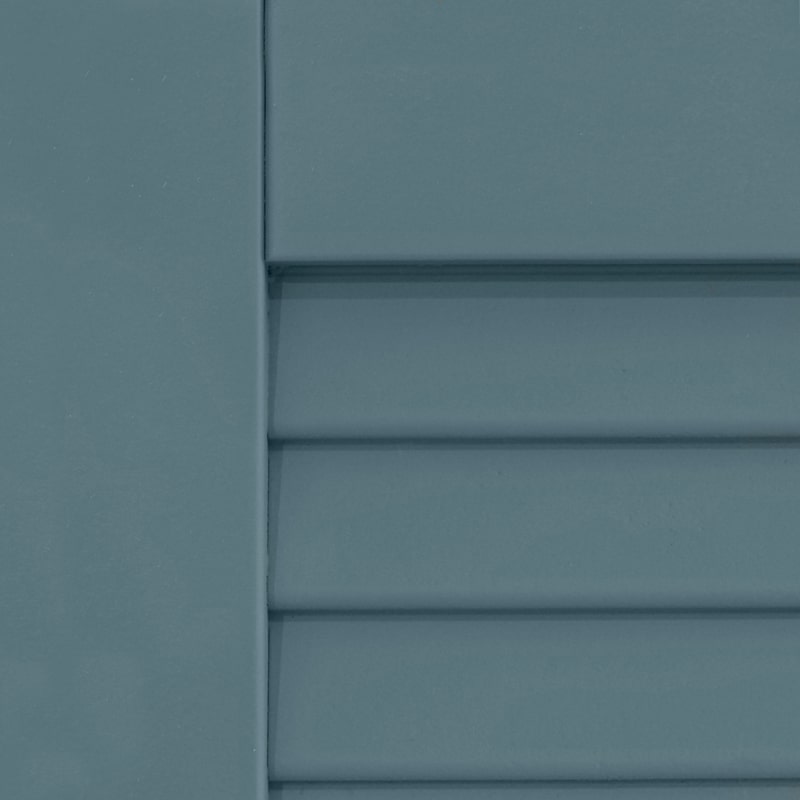 Hamilton Blue
Hamilton Blue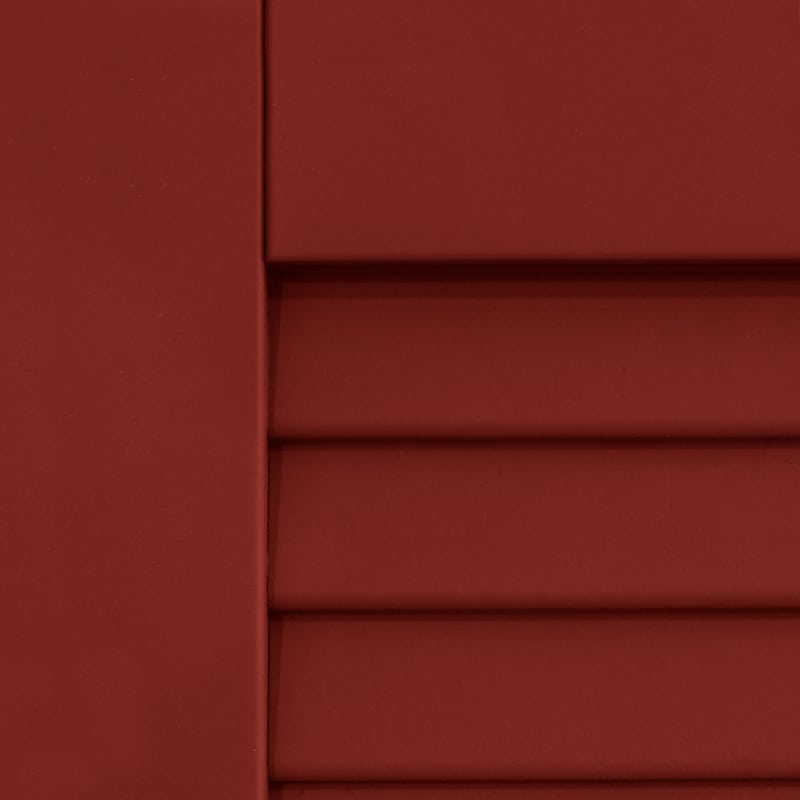 Country Redwood
Country Redwood Cottage Red
Cottage Red Tudor Brown
Tudor Brown

Unfinished - Paint Grade
Unfinished shutters are raw with no finish applied. All surfaces are thoroughly sanded. Small blemishes are repaired with wood filler, which will arrive sanded smooth and ready to finish. Filled areas will not diminish the integrity of the shutter or show through the paint. Priming is recommended to seal the grain and support paint adhesion.

Unfinished - Stain Grade
Unfinished shutters are raw with no finish applied. All surfaces are thoroughly sanded. Wood is selected for a relatively uniform grain. Minor blemishes (if any) are repaired with stainable wood filler, which will arrive sanded smooth and ready to finish. Filled areas will not diminish the integrity or appearance of the shutter.

Primed
Primed shutters are sprayed with Benjamin Moore Aqua Lock Plus acrylic water-based universal primer / sealer. This primer provides complete coverage to seal the porous raw surface, block stains and prevent bleed-through. The medium gray primed surface will need to be sanded with 220 grit sandpaper and wiped clear of dust before painting.

Standard Paint Colors
Select from 9 standard paint colors. Painted exterior shutters are sanded, primed, sanded, and sprayed with two ultra-durable, water-borne commercial-grade Benjamin Moore Corotech COMMAND acrylic top coats. The factory applied paint covers all surfaces in a smooth satin sheen finish.

Custom Paint Colors
Read moreChoose a custom paint color for a one-time amount of $200 to match the color (NOT per shutter). Provide the paint manufacturer, color name, and color code to match. Or a color chip or physical sample may be mailed to match.
Painted exterior shutters are sanded, primed, sanded, and sprayed with two ultra-durable, water-borne commercial-grade Benjamin Moore Corotech COMMAND acrylic top coats. The factory applied paint covers all surfaces in a smooth satin sheen finish.

Straight Top
Straight top shutters have a standard horizontal top rail.
*Image represents single wide shutters; double wide shutter have a vertical sub-stile.

Cathedral Top
A cathedral top is made with a small arc at the bottom of the top rail.
*Image represents single wide shutters; double wide shutter have a vertical sub-stile.

Arch Top 1:1 Drop
The arch of a 1:1 drop is equal to the width. So the measurement from the top of the shutter down to the start of the arch is the same as the shutter width.
A pair of arch top shutters includes one shutter with the arch on the left side and one with the arch on the right.
*Double wide shutter cannot be made with an arch top.

Arch Top Custom Drop
A custom arch requires a springline measurement.
Springline – the dimension from the top of the shutter down to the start of the arch.
A pair of arch top shutters includes one shutter with the arch on the left side and one with the arch on the right.
*Double wide shutter cannot be made with an arch top.

Shutter Screws
Shutter screws are best used to install vinyl shutters to wood siding. The screw heads are painted to match the shutter color.
Shutters are not pre-drilled.

Shutter Spikes
How to Install Vinyl ShuttersVinyl shutter spikes are designed to secure shutters to most surfaces. Screws are usually better for installing to wood. Scales, or ridges, of the shutter spike hold the apparatus in position. They are color coordinated to match the shutters.
Shutters are not pre-drilled.
Vinyl Louvered Shutter Configurations

#1
100% louvers top to bottom
At least one divider rail is required when the shutter height is equal to or greater than 55″. This option becomes unavailable when the height selected exceeds 54.75″.
The illustration depicts only the stiles and rails.
Louvers fill the open area.*Image represents single wide shutters; double wide shutter have a vertical sub-stile.

#2
One centered divider rail
50% louvers above
50% louvers belowThe illustration depicts only the stiles and rails.
Louvers fill the open area.*Image represents single wide shutters; double wide shutter have a vertical sub-stile.

#3
Two divider rails
33% louvers at top
33% louvers at center
33% louvers at bottomThe illustration depicts only the stiles and rails.
Louvers fill the open area.*Image represents single wide shutters; double wide shutter have a vertical sub-stile.

#4
Two divider rails
20% louvers at top
60% louvers at center
20% louvers at bottomThe illustration depicts only the stiles and rails.
Louvers fill the open area.*Image represents single wide shutters; double wide shutter have a vertical sub-stile.

#5
One divider rail
60% louvers above
40% louvers belowThe illustration depicts only the stiles and rails.
Louvers fill the open area.*Image represents single wide shutters; double wide shutter have a vertical sub-stile.

#6
Three divider rails
25% louvers at top
25% louvers at center
25% louvers at center
25% louvers at bottomThe illustration depicts only the stiles and rails.
Louvers fill the open area.*Image represents single wide shutters; double wide shutter have a vertical sub-stile.

#7
One divider rail
40% louvers above
60% louvers belowThe illustration depicts only the stiles and rails.
Louvers fill the open area.*Image represents single wide shutters; double wide shutter have a vertical sub-stile.

#8
Two divider rails
20% louvers at top
40% louvers at center
40% louvers at bottomThe illustration depicts only the stiles and rails.
Louvers fill the open area.*Image represents single wide shutters; double wide shutter have a vertical sub-stile.

#9
One divider rail
20% louvers above
80% louvers belowThe illustration depicts only the stiles and rails.
Louvers fill the open area.*Image represents single wide shutters; double wide shutter have a vertical sub-stile.

#10
Two divider rails
40% louvers at top
20% louvers at center
40% louvers at bottomThe illustration depicts only the stiles and rails.
Louvers fill the open area.*Image represents single wide shutters; double wide shutter have a vertical sub-stile.

Shutter Screws
Shutter screws are included to install board and batten vinyl shutters. The screw heads are painted to match the shutter color.
Shutter spikes are not long enough to extend through both the board and batten.
Shutters are not pre-drilled.
A divider rail is a horizontal bar (much like the top rail) that creates solid panel areas above and below the division.

No Divider Rail
Solid panel with no divider rail

One Divider Rail
Solid panel with one divider rail
Division Point 1: Measure from the bottom of the shutter to the desired center of the divider rail

Two Divider Rails
Solid panel with two divider rails
Division Point 1: Measure from the bottom of the shutter to the desired center of the first divider rail
Division Point 2: Measure from the bottom of the shutter to the desired center of the second divider rail

Raised Panel
Raised panels have beveled edges with a flat plateau in the center. The solid flat panel section is composite.

Flat Panel
Flat panel shutters are constructed with a central even surface with no detail. The solid flat panel section is composite.
Grooved Shaker Panel
Shaker panel shutters are fabricated with vertical grooves cut into the central surface. The solid grooved panel section is composite. The number of grooves is based on the shutter width.
Vertical grooves:
2 grooves for shutter widths 14” to 17 ¾”
3 grooves for shutter widths 18” to 23 ¾”
4 grooves for shutter widths 24” to 31 ¾”
5 grooves for shutter widths 32” to 39 ¾”
6 grooves for shutter widths 40” to 45”
A divider rail is a horizontal bar (much like the top rail) that creates one louver area above or below the division with a solid panel in the other section.

Divider Rail
A horizontal divider rail is necessary to separate the top section of a combination shutter from the bottom. The solid panel section is composite. Divider rail size is displayed under “Dimensions” on the main order page
- Select “Centered” or
- Measure from the bottom of the shutter to the desired center of the divider rail for a “Custom” location and record that dimension as the “Division Point”
* The actual location of the divider rail may be slightly higher or lower than requested. The number of louvers will dictate the final placement.

Straight Top Shutters
Straight top shutters are manufactured with a square horizontal top.

Arch Top Shutters
More about arch top shuttersArch top shutters are made with a curved top.
The specified shutter height is the dimension of the long vertical edge of the shutter.
The required springline is the measurement from the top of the shutter down to the start of the arch.
Measure Composite Shutters
Composite exterior shutters install in a stationary position to the side of the window with the included Lexan polycarbonate fixed mounting brackets.
The v-shaped 1-1/8″ x 1-1/8″ brackets are specifically suited for use with outdoor composite shutters. The vertical side of the bracket attaches to the building and the horizontal side to the top or bottom of the shutter. The brackets extend the full width of the shutter and are not easily visible after installation.
Measure Wood Board & Batten Shutters
Wood exterior shutters install to the side of the window using one of two methods.
Stationary shutters permanently attach to the side of the window in a fixed location.
Functional shutters mount with operable exterior hardware to pivot from a position flanking the window to cover the window opening.
How the window is measured depends on which of these two options is selected.

Vertical Boards
The number of boards is based on the shutter width.
3 boards for widths 12” to 17 ¾”
4 boards for widths 18” to 23 ¾”
5 boards for widths 24” to 31 ¾”
6 boards for widths 32” to 39 ¾”
7 boards for widths 40” to 48”
Measure Composite Board & Batten Shutters
Composite exterior shutters install in a stationary position to the side of the window with the included Lexan polycarbonate fixed mounting brackets.
The v-shaped 1-1/8″ x 1-1/8″ brackets are specifically suited for use with outdoor composite shutters. One side of the bracket attaches to the building. The vertical side of the bracket attaches to the building. The brackets extend the full width of the shutter and are not easily visible after installed.
The shutter measurements are based on the window

Vertical Boards
The illusion of boards is created with vertical grooves cut into the solid composite sheet. The number of boards is based on the shutter width.
3 boards for widths 12” to 17 ¾”
4 boards for widths 18” to 23 ¾”
5 boards for widths 24” to 31 ¾”
6 boards for widths 32” to 39 ¾”
7 boards for widths 40” to 48”

Two Horizontal Battens
Top batten placed 7” below top of shutter
Bottom batten placed 7” above bottom of shutter
Battens 3.5″ in height
Width 0.75” less than shutter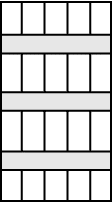
Three Horizontal Battens
Top batten placed 7” below top of shutter
Batten placed at center
Bottom batten placed 7” above bottom of shutter
Battens 3.5″ in height
Width 0.75” less than shutter
Four Horizontal Battens
Top batten placed 7” below top of shutter
Two battens equally spaced between top and bottom
Bottom batten placed 7” above bottom of shutter
Battens 3.5″ in height
Width 0.75” less than shutter
Z-pattern
Top batten placed 7” below top of shutter
Batten placed at diagonal from bottom right of top batten to top left of bottom batten
Bottom batten placed 7” above bottom of shutter
Battens 3.5″ in height
Width 0.75” less than shutter
Reverse Z-pattern
Top batten placed 7” below top of shutter
Batten placed at diagonal from bottom left of top batten to top right of bottom batten
Bottom batten placed 7” above bottom of shutter
Battens 3.5″ in height
Width 0.75” less than shutter

Two Horizontal Battens
Top batten placed 7” below top of shutter
Bottom batten placed 7” above bottom of shutter
Battens 3.5″ in height
Width 0.75” less than shutterConfiguration optional when shutter height less than 55″.
A third batten is required when the shutter height is equal to or greater than 55″. (The two batten option will become unavailable on the order page)

Three Horizontal Battens
Top batten placed 7” below top of shutter
Batten placed at center
Bottom batten placed 7” above bottom of shutter
Battens 3.5″ in height
Width 0.75” less than shutter
Four Horizontal Battens
Top batten placed 7” below top of shutter
Two battens equally spaced between top and bottom
Bottom batten placed 7” above bottom of shutter
Battens 3.5″ in height
Width 0.75” less than shutter
Z-pattern
Top batten placed 7” below top of shutter
Batten placed at diagonal from bottom right of top batten to top left of bottom batten
Bottom batten placed 7” above bottom of shutter
Battens 3.5″ in height
Width 0.75” less than shutter
Reverse Z-pattern
Top batten placed 7” below top of shutter
Batten placed at diagonal from bottom left of top batten to top right of bottom batten
Bottom batten placed 7” above bottom of shutter
Battens 3.5″ in height
Width 0.75” less than shutter

1.75" Louvers (Standard)
- 1.75″ wide
- 0.25″ thick
- Length 4.25″ less than shutter width
- Spaced on 1.75″ centers
- Space between louvers
- Fixed 40° angle – do not rotate
- Number of louvers determined by shutter height
Return to order page to calculate in “Specifications” section - Slotted in 1.5″ side stiles

1.5" Louvers
- 1.5″ wide
- 0.25″ thick
- Length 4.25″ less than shutter width
- Spaced on 1.5″ centers
- Space between louvers
- Fixed 40° angle – do not rotate
- Number of louvers determined by shutter height
Return to order page to calculate in “Specifications” section - Slotted in 1.5″ side stiles
- Adds $25 per shutter
ShutterLand’s manufacturing process has been streamlined to keep costs and manufacturing time at a minimum. Therefore, we do not deviate from these two louver sizes.
Bahama shutters are uniquely designed to span the width of entire windows. A vertical sub-stile is used to create multiple louver areas to prevent them from exceeding their natural width limitation. The number of sub-stiles based on the schedule below.

No Sub-Stile
Shutter Width: 16 – 27″
(Option automatically removed from the order page if shutter width is outside of these parameters)

One Sub-Stile
Shutter Width: 24 – 50″
(Option automatically removed from the order page if shutter width is outside of these parameters)
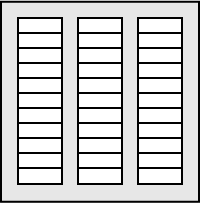
Two Sub-Stiles
Shutter Width: 36 – 60″
(Option automatically removed from the order page if shutter width is outside of these parameters)

Three Sub-Stiles
Shutter Width: 48 – 60″
(Option automatically removed from the order page if shutter width is outside of these parameters)

Four Sub-Stiles
Shutter Width: 60″
(Option automatically removed from the order page if shutter width is outside of these parameters)
Bahama shutters are uniquely designed to span the width of entire windows. A vertical sub-stile is used to create multiple louver areas to prevent them from exceeding their natural width limitation. The number of sub-stiles based on the schedule below.

No Sub-Stile
Shutter Width: 15 – 23.5″
(Option automatically removed from the order page if shutter width is outside of these parameters)

One Sub-Stile
Shutter Width: 23.75 – 45″
(Option automatically removed from the order page if shutter width is outside of these parameters)

Two Sub-Stiles
Shutter Width: 36 – 66.25″
If the shutter width exceeds 65″, all stile sizes will increase incrementally up to 4”. Select a greater number of sub-stiles to keep stiles at standard 2.125″.
(Option automatically removed from the order page if shutter width is outside of these parameters)

Three Sub-Stiles
Shutter Width: 48 – 85″
(Option automatically removed from the order page if shutter width is outside of these parameters)

Four Sub-Stiles
Shutter Width: 60 – 85″
(Option automatically removed from the order page if shutter width is outside of these parameters)

Measure Bahama Shutters
Full Measuring InstructionsBahama shutters install to the top of a window with functional hinges and extend away from the building at the bottom with shutter stays. The shutter can nest inside of a window opening with sufficient depth or sit just proud of the trim. Most Bahama shutters cover the full height of the window, while others are shorter and serve as a canopy over the top portion.

No Gap Between Boards
Boards arranged tight together
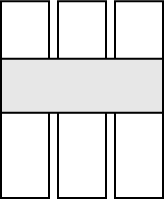
Gap Between Boards
Arranged with 1/4 inch gap between boards
Individual board widths are adjusted to accommodate the gap and maintain the specified shutter width
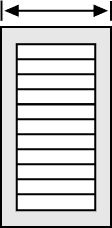
Single Wide Shutter Width
Single Wide shutters have one vertical bank of louvers. They are available in 7 set widths.
Suggested shutter widths based on window size:
Window Width Single Wide Shutter Width 16″ or smaller 7″ 17″ – 22″ 9″ or 10″ 23″ – 31″ 12″ or 14.5″ 32″ – 40″ 14.5″, 16.25″ or 17.75″ 
Double Wide Shutter Widths
Double Wide vinyl shutters are made with a center vertical style for support that creates left and right louver areas. They are available in 8 widths.
Suggested shutter widths based on window size:
Window Width Double Wide Shutter Width 23″ – 31″ 13″ 32″ – 40″ 14.875″ or 19″ 41″ – 45″ 19″ or 20.875″ 46″ – 53″ 23.875″ or 25.75″ 54″ + 27.5″ or 29″ 
Shutter Height
20 – 97″ in ¼″ increments

Vinyl Shutters
Vinyl shutters in the 19 standard colors are constructed from Polypropylene. The color is molded through the material and shutters arrive ready to install. Polypropylene cannot be painted. The paintable finish shutters are fabricated from Polystyrene and are translucent opal in color.
All vinyl shutters have a wood grain textured surface. Vinyl shutters are constructed in the form of a shell, with four sides, a front and a hollow back. The panels can feel flimsy right out of the box and may not have the rigidity one expects from wood or composite shutters. They gain great strength and stability when they are attached to the building.

Vinyl Shutters
Vinyl shutters in the 19 standard colors are constructed from Polypropylene. The color is molded through the material and arrive ready to install. Polypropylene cannot be painted. The paintable finish shutters are fabricated from Polystyrene and are translucent opal in color.
All vinyl shutters have a wood grain textured surface. Vinyl shutters are are constructed in the form of a shell, with four sides, a front and a hollow back. The panels can feel flimsy right out of the box and may not have the rigidity one expects from wood or composite shutters. They gain great strength and stability when they are attached to the building.
Vinyl shutters are available in 19 standard colors plus one paintable version. Colors are molded through the vinyl material for a lifetime finish. If color is critical, do not make a selection from a digital display. Request free color samples for physical onsite examination. Prefinished colors cannot be painted.
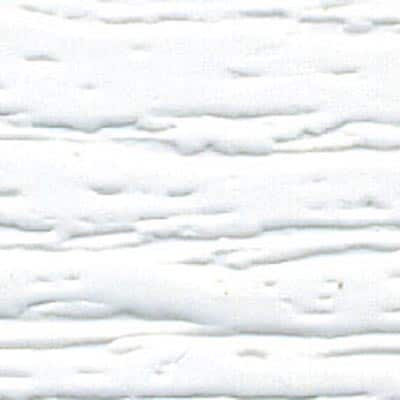 White #001
White #001 Black #002
Black #002 Bedford Blue #004
Bedford Blue #004 Brick Red #005
Brick Red #005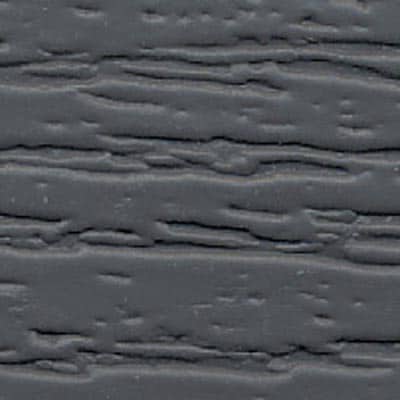 Dark Grey #007
Dark Grey #007 Colonial Blue #008
Colonial Blue #008 Pine Green #009
Pine Green #009 Sandalwood #011
Sandalwood #011 Bronze #018
Bronze #018 Sage #020
Sage #020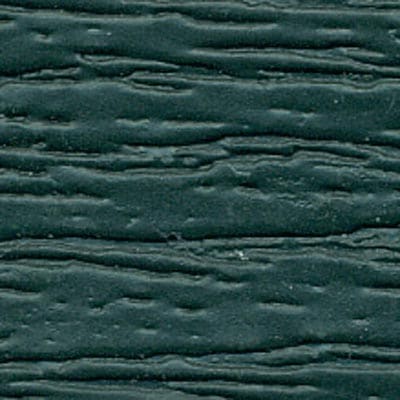 Ebony Green #021
Ebony Green #021 Sienna Brown #025
Sienna Brown #025 Potters Clay #200
Potters Clay #200 Chocolate Chip #206
Chocolate Chip #206 Lunar Blue #208
Lunar Blue #208 Burgundy #260
Burgundy #260 Heritage Green #331
Heritage Green #331 Dove Grey #352
Dove Grey #352 Cranberry #613
Cranberry #613

Single Wide Shutter Width
Single Wide shutters are available in 7 set widths.
Suggested shutter widths based on window size:
Window Width Single Wide Shutter Width 16″ or smaller 7″ 17″ – 22″ 9″ or 10″ 23″ – 31″ 12″ or 14.5″ 32″ – 40″ 14.5″, 16.25″ or 17.75″ 
Double Wide Shutter Widths
Double Wide vinyl shutters are made with a center vertical style for support that creates left and right raised panel areas. They are available in 8 widths.
Suggested shutter widths based on window size:
Window Width Double Wide Shutter Width 23″ – 31″ 13″ 32″ – 40″ 14.875″ or 19″ 41″ – 45″ 19″ or 20.875″ 46″ – 53″ 23.875″ or 25.75″ 54″ + 27.5″ or 29″ 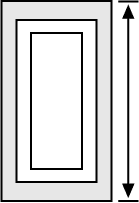
Shutter Height
20 – 97″ in ¼″ increments

Single Wide Shutter Width
Single Wide shutters are available in 7 set widths.
Suggested shutter widths based on window size:
Window Width Single Wide Shutter Width 16″ or smaller 7″ 17″ – 22″ 9″ or 10″ 23″ – 31″ 12″ or 14.5″ 32″ – 40″ 14.5″, 16.25″ or 17.75″ 
Double Wide Shutter Widths
Double Wide vinyl shutters are made with a center vertical style for support that creates left and right areas. They are available in 8 widths.
Suggested shutter widths based on window size:
Window Width Double Wide Shutter Width 23″ – 31″ 13″ 32″ – 40″ 14.875″ or 19″ 41″ – 45″ 19″ or 20.875″ 46″ – 53″ 23.875″ or 25.75″ 54″ + 27.5″ or 29″ 
Shutter Height
20 – 97″ in ¼″ increments

Rectangular Straight Top
Straight top shutters have a standard horizontal top rail.
*Image represents single wide shutters; double wide shutter have a vertical sub-stile.

Eyebrow Top
Eyebrow top shutters are made with a slight curve in the top from the high side of the shutter down to the opposite side. Select from either a 1″, 2″ or 3″ drop. The drop (also called the springline) is the measurement from the top of the shutter down to the start of the curve. The shape of the raised panel area will remain rectangular.
A pair of eyebrow top shutters includes one shutter with the drop on the left side and one with the drop on the right.
*Only single wide shutters can be made with an eyebrow top. Double wide shutter have a vertical sub-stile and can only be made with a straight top.
Vinyl Raised Panel Shutter Configurations

#1
100% raised panel top to bottom
At least one divider rail is required when the shutter height is equal to or greater than 55″. This option becomes unavailable when the height selected exceeds 54.75″.
The illustration depicts only the stiles and rails.
A raised panel fills the open area.*Image represents single wide shutters; double wide shutter have a vertical sub-stile.

#2
One centered divider rail
50% raised panel above
50% raised panel belowThe illustration depicts only the stiles and rails.
A raised panel fills the open area.*Image represents single wide shutters; double wide shutter have a vertical sub-stile.

#3
Two divider rails
33% raised panel at top
33% raised panel at center
33% raised panel at bottomThe illustration depicts only the stiles and rails.
A raised panel fills the open area.*Image represents single wide shutters; double wide shutter have a vertical sub-stile.

#4
Two divider rails
20% raised panel at top
60% raised panel at center
20% raised panel at bottomThe illustration depicts only the stiles and rails.
A raised panel fills the open area.*Image represents single wide shutters; double wide shutter have a vertical sub-stile.

#5
One divider rail
60% raised panel above
40% raised panel belowThe illustration depicts only the stiles and rails.
A raised panel fills the open area.*Image represents single wide shutters; double wide shutter have a vertical sub-stile.

#6
Three divider rails
25% raised panel at top
25% raised panel at center
25% raised panel at center
25% raised panel at bottomThe illustration depicts only the stiles and rails.
A raised panel fills the open area.*Image represents single wide shutters; double wide shutter have a vertical sub-stile.

#7
One divider rail
40% raised panel above
60% raised panel belowThe illustration depicts only the stiles and rails.
A raised panel fills the open area.*Image represents single wide shutters; double wide shutter have a vertical sub-stile.

#8
Two divider rails
20% raised panel at top
40% raised panel at center
40% raised panel at bottomThe illustration depicts only the stiles and rails.
A raised panel fills the open area.*Image represents single wide shutters; double wide shutter have a vertical sub-stile.

#9
One divider rail
20% raised panel above
80% raised panel belowThe illustration depicts only the stiles and rails.
A raised panel fills the open area.*Image represents single wide shutters; double wide shutter have a vertical sub-stile.

#10
Two divider rails
40% raised panel at top
20% raised panel at center
40% raised panel at bottomThe illustration depicts only the stiles and rails.
A raised panel fills the open area.*Image represents single wide shutters; double wide shutter have a vertical sub-stile.

Rectangular Straight Top
Straight top shutters have a standard horizontal top rail.
*Image represents single wide shutters; double wide shutter have a vertical sub-stile.

Eyebrow Top
Eyebrow top shutters are made with a slight curve in the top from the high side of the shutter down to the opposite side. Select from either a 1″, 2″ or 3″ drop. The drop is the measurement from the top of the shutter down to the start of the curve. The shape of the top raised panel or louver area will remain rectangular.
*Only single wide shutters can be made with an eyebrow top. Double wide shutter have a vertical sub-stile and can only be made with a straight top.

Vinyl Shutters
Vinyl shutters in the 19 standard colors are constructed from Polypropylene. The color is molded through the material and arrive ready to install. Polypropylene cannot be painted. The paintable finish shutters are fabricated from Polystyrene and are translucent opal in color.
All vinyl shutters have a wood grain textured surface. Vinyl shutters are are constructed in the form of a shell, with four sides, a front and a hollow back. The panels can feel flimsy right out of the box and may not have the rigidity one expects from wood or composite shutters. They gain great strength and stability when they are attached to the building.
Vinyl Combo Shutter Configurations

#101
One centered divider rail
50% raised panel above
50% louvered below*Image represents single wide shutters; double wide shutter have a vertical sub-stile.

#105
Two divider rails
33% louvers at top
33% raised panel at center
33% louvers at bottom*Image represents single wide shutters; double wide shutter have a vertical sub-stile.

#107
Three divider rails
25% louvers at top
25% raised panel at center
25% louvers at center
25% raised panel at bottom*Image represents single wide shutters; double wide shutter have a vertical sub-stile.

#109
One divider rail
50% louvered above
50% raised panel below*Image represents single wide shutters; double wide shutter have a vertical sub-stile.

#112
Two divider rails
33% raised panel at top
33% louvered center
33% raised panel at bottom*Image represents single wide shutters; double wide shutter have a vertical sub-stile.

#115
Two divider rails
20% louvers at top
60% raised panel at center
20% louvered at bottom*Image represents single wide shutters; double wide shutter have a vertical sub-stile.

Closed Weave Shutter Size
Board & Batten closed weave shutters are available in seven fixed widths. The individual board widths are 3.375″.
2 boards: 6.875″
3 boards: 10.25″
4 boards: 13.875″
5 boards: 17.25″
6 boards: 20.75″
7 boards: 23.875″
8 boards: 27.25″Height: 20 – 97″ in 0.25″ increments

Open Weave Shutter Size
Board & Batten open weave shutters are available in seven fixed widths. The individual board widths are 3.375″ with a 0.75″ – 0.875″ gap between boards.
2 boards: 7.625″
3 boards: 12″
4 boards: 16″
5 boards: 20″
6 boards: 24.375″
7 boards: 28.625″
8 boards: 33″Height: 20 – 97″ in 0.25″ increments
Vinyl Board & Batten Shutter Configurations

#1
2 battens (each 3.375″ in height)
Top batten below the top of the shutter*
Bottom batten above the bottom of the shutter*
#2
3 battens (each 3.375″ in height)
Top batten below the top of the shutter*
50% space
Center batten
50% space
Bottom batten above the bottom of the shutter*
#3
4 battens (each 3.375″ in height)
Top batten below the top of the shutter*
33% space
Center batten
33% space
Center batten
33% space
Bottom batten above the bottom of the shutter*
#4
4 battens (each 3.375″ in height)
Top batten below the top of the shutter*
20% space
Center batten
60% space
Center batten
20%
Bottom batten above the bottom of the shutter*
#5
3 battens (each 3.375″ in height)
Top batten below the top of the shutter*
60% space
Center batten
40% space
Bottom batten above the bottom of the shutter*
#6
5 battens (each 3.375″ in height)
Top batten below the top of the shutter*
25% space
Center batten
25% space
Center batten
25% space
Center batten
25% space
Bottom batten above the bottom of the shutter*
#7
3 battens (each 3.375″ in height)
Top batten below the top of the shutter*
40% space
Center batten
60% space
Bottom batten above the bottom of the shutter*
#8
4 battens (each 3.375″ in height)
Top batten below the top of the shutter*
20% space
Center batten
40% space
Center batten
40% space
Bottom batten above the bottom of the shutter*
#9
3 battens (each 3.375″ in height)
Top batten below the top of the shutter*
20% space
Center batten
80% space
Bottom batten above the bottom of the shutter*
#10
4 battens (each 3.375″ in height)
Top batten below the top of the shutter*
40% space
Center batten
20% space
Center batten
40% space
Bottom batten above the bottom of the shutter*
#11
2 horizontal battens*
& 1 diagonal batten forming a z or reverse-z
(each 3.375″ in height)Pair includes one z-pattern shutter and one reverse z-pattern shutter

#12
3 battens (each 3.375″ in height)
Top batten at top edge of shutter
50% space
Center batten
50% space
Bottom batten at bottom edge of shutter
#13
2 horizontal battens
& 2 diagonal batten forming an x
(each 3.375″ in height)Top batten positioned at top edge and bottom batten at bottom edge

#14
2 battens (each 3.375″ in height)
Battens are positioned in relation to the shortest board*Boards are of various heights.
The shutter height is the length of the longest board. The next board in succession is 3” shorter than the previous. The bottom of all boards are even. The pattern repeats for all boards.
Pair includes one left shutter and one right shutter

#16
4 battens (each 3.375″ in height)
Top batten at top edge of shutter
33% space
Center batten
33% space
Center batten
33% space
Bottom batten at bottom edge of shutter
#17
2 battens (each 3.375″ in height)
Top batten at top edge of shutter
Bottom batten at Bottom edge of shutter
#18
2 battens (each 3.375″ in height)
Battens are positioned in relation to the shortest board*Boards are two heights.
The shutter height is the length of the longest board. Shorter boards are 3” shorter at the top and 3″ shorter at the bottom than the longer boards, which are vertically centered. The pattern repeats for all boards.

#19
6 battens (each 3.375″ in height)
Top batten at top edge of shutter
20% space
Center batten
20% space
Center batten
20% space
Center batten
20% space
Center batten
20% space
Bottom batten at bottom edge of shutter
#21
2 battens (each 3.375″ in height)
Battens are positioned in relation to the shortest board*Boards are of various heights.
The shutter height is the length of the longest board. The next board in succession is 3” shorter than the previous. The bottom of all boards are even. The pattern repeats for all boards.

#22
2 battens (each 3.375″ in height)
Battens are positioned in relation to the shortest board*The shutter height is the length of the longest board located at center. The two boards on either side are 6” shorter and centered.
This style is only for 3 boards across.
*Batten location from the top or bottom of the shortest board to the batten depends on the shutter height. Applies to styles #1 – #10, #11, #14, #18, #21 and #22.
| Shutter Height | Distance from Top or Bottom to Batten |
| 0″ – 24″ | 2″ |
| 25″ – 36″ | 3″ |
| 37″ – 48″ | 4″ |
| 49″ + | 6.5″ |

Vinyl Shutters
Vinyl shutters in the 19 standard colors are constructed from Polypropylene. The color is molded through the material and arrive ready to install. Polypropylene cannot be painted. The paintable finish shutters are fabricated from Polystyrene and are a translucent opal in color.
All vinyl shutters have a wood grain textured surface. Both boards and battens are are constructed in the form of a shell, with four sides, a front and a hollow back (shown at left). Both the boards and battens have a cap at either end of the component. The panels can feel flimsy right out of the box and may not have the rigidity one expects from wood or composite shutters. They gain great strength and stability when they are attached to the building.

1.75" Louvers (Standard)
- 1.75″ wide (see illustration)
- 0.25″ thick
- Length 4.25″ less than shutter width
- Spaced on 1.75″ centers
- 0.1875″ between louvers
- Fixed 17° angle – do not rotate
- Number of louvers determined by shutter height
Return to order page to calculate in “Specifications” section

1.5" Louvers
- 1.5″ wide (see illustration)
- 0.25″ thick
- Length 4.25″ less than shutter width
- Spaced on 1.5″ centers
- 0.1875″ between louvers
- Fixed 17° angle – do not rotate
- Number of louvers determined by shutter height
Return to order page to calculate in “Specifications” section - Adds $25 per shutter

Louvers Down
Louvers can be oriented in a down position.
This option is recommended.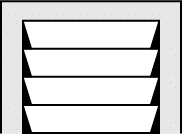
Louvers Up
Louvers can be oriented in an up position.

Faux Tilt Bar
A tilt bar is a narrow vertical wood rod that interconnects a group of horizontal louvers. A tilt bar used in conjunction with movable louvers unifies the slats and allows them to rotate at one time. Louvers on ShutterLand premium wood louvers are fixed in position and do not rotate. A faux tilt bar can be attached to replicate the appearance of movable louvers, usually for historical purposes. Selection of a tilt bar adds $40 to the price of each shutter.
Most exterior shutter applications do not require a tilt bar.

Faux Tilt Bar
A tilt bar is a narrow vertical wood rod that interconnects a group of horizontal louvers. A tilt bar used in conjunction with movable louvers unifies the slats and allows them to rotate at one time. Louvers on ShutterLand composite louvers are fixed in position and do not rotate. A faux tilt bar can be attached to replicate the appearance of movable louvers, usually for historical purposes. Selection of a tilt bar adds $40 to the price of each shutter.
Most exterior shutter applications do not require a tilt bar.

1.75" Composite Louvers (Standard)
- 1.75″ visible surface area (see illustration)
- Length 5″ less than shutter width
- Louver sections made in one-piece (not separate, individual louvers)
- No space between louvers
- Fixed down at 10° angle

1" Composite Louvers
- 1″ visible surface area (see illustration)
- Length 5″ less than shutter width
- Louver sections made in one-piece (not separate, individual louvers)
- No space between louvers
- Fixed down at 20° angle
- Adds $15 per shutter

Louvers Down
Louvers can positioned in a down position.
This position is recommended because the louvers shed moisture.

Louvers Up
Louvers can positioned in a up position. This is not a standard option and can ordered only by special request.
Up oriented louvers are not recommend because there is no space between the louvers resulting in a potential for water to reside in the grooves which may shorten the lifespan of the shutters.

Faux Tilt Bar
A tilt bar is a narrow vertical wood rod that interconnects a group of horizontal louvers. A tilt bar used in conjunction with movable louvers unifies the slats and allows them to rotate at one time. Louvers on ShutterLand composite louvers are fixed in position and do not rotate. A faux tilt bar can be attached to replicate the appearance of movable louvers, usually for historical purposes. Selection of a tilt bar adds $40 to the price of each shutter.
Most exterior shutter applications do not require a tilt bar.
A divider rail is a horizontal bar (much like the top rail) that creates louver areas above and below the division. The divider rail height is 2.125″.

No Divider Rail
- Configuration allowable when the shutter is shorter than 70″
- The “No” divider rail button becomes unavailable on the order page when height is greater than or equal to 70″

One Divider Rail
- Measure from the bottom of the shutter to the desired center of the divider rail
- Optional when the shutter is shorter than 70″
- Required if height is greater than or equal to 70″
- Divider rail size is displayed under “Specifications” on the main order page
* The actual location of the divider rail may be slightly higher or lower than requested. The number of louvers will dictate the final placement.

Two Divider Rails
- Measure from the bottom of the shutter to the desired center of the first divider rail
- Then, measure from the bottom of the shutter to the desired center of the second divider rail
- Divider rail size is displayed under “Specifications” on the main order page
* The actual location of the divider rail may be slightly higher or lower than requested. The number of louvers will dictate the final placement.
A divider rail is a horizontal bar (much like the top rail) that creates raised panel areas above and below the division. The divider rail height is 2.5″.

No Divider Rail
- Configuration allowable when the shutter is shorter than 70″
- The “No” divider rail button becomes unavailable on the order page when height is greater than or equal to 70″

One Divider Rail
- Measure from the bottom of the shutter to the desired center of the divider rail
- Optional when the shutter is shorter than 70″
- Required if height is greater than or equal to 70″
- Divider rail size is displayed under “Specifications” on the main order page

Two Divider Rails
- Measure from the bottom of the shutter to the desired center of the first divider rail
- Then, measure from the bottom of the shutter to the desired center of the second divider rail
- Divider rail size is displayed under “Specifications” on the main order page
A divider rail is a horizontal bar (much like the top rail) that creates solid panel areas above and below the division. The divider rail height is 2.5″.

No Divider Rail
- Configuration allowable when the shutter is shorter than 70″
- The “No” divider rail button becomes unavailable on the order page when height is greater than or equal to 70″

One Divider Rail
- Measure from the bottom of the shutter to the desired center of the divider rail
- Optional when the shutter is shorter than 70″
- Required if height is greater than or equal to 70″
- Divider rail size is displayed under “Specifications” on the main order page

Two Divider Rails
- Measure from the bottom of the shutter to the desired center of the first divider rail
- Then, measure from the bottom of the shutter to the desired center of the second divider rail
- Divider rail size is displayed under “Specifications” on the main order page

Southern Yellow Pine
Southern Yellow Pine is the most affordable solid wood option. This wood has a beautiful golden color with a distinct wood grain pattern that is 99.9% knot free. It is kiln-dried to minimum moisture content and cut to 1″ thick shutters. The joints between stiles and rails are glued, doweled, and screwed for ultimate strength. Paneled area is composite (see below).
Southern Yellow Pine shutters are considered entry-level, or builder grade, with lower performance standards compared to 1.5″ thick premium wood shutters.

Composite Solid Panel
The central solid panel is fabricated from Extira, a composite material manufactured from sustainable wood fibers and marine-grade resins. Extira is designed for outdoor applications where humidity and moisture varies. It is strong, resilient and holds its shape in all weather conditions.

1.75" Louvers (Standard)
- 1.75″ wide
- 0.25″ thick
- Length 4.25″ less than shutter width
- Spaced on 1.75″ centers
- 0.1875″ between louvers
- Fixed 17° angle – do not rotate
- Number of louvers determined by shutter height
Return to order page to calculate in “Specifications” section

1.5" Louvers
- 1.5″ wide
- 0.25″ thick
- Length 4.25″ less than shutter width
- Spaced on 1.5″ centers
- 0.1875″ between louvers
- Fixed 17° angle – do not rotate
- Number of louvers determined by shutter height
Return to order page to calculate in “Specifications” section - Adds $25 per shutter
A divider rail is a horizontal bar (much like the top rail) that creates louver areas above and below the division. The divider rail height is 3.5″.

No Divider Rail
- Configuration allowable when the shutter is shorter than 70″
- The “No” divider rail button becomes unavailable on the order page when height is greater than or equal to 70″

One Divider Rail
- Measure from the bottom of the shutter to the desired center of the divider rail*
- Optional when the shutter is shorter than 70″
- Required if height is greater than or equal to 70″
- Divider rail size is displayed under “Specifications” on the main order page
* The actual location of the divider rail may be slightly higher or lower than requested. The number of louvers will dictate the final placement.

Two Divider Rails
- Measure from the bottom of the shutter to the desired center of the first divider rail*
- Then, measure from the bottom of the shutter to the desired center of the second divider rail*
- Divider rail size is displayed under “Specifications” on the main order page
* The actual location of the divider rails may be slightly higher or lower than requested. The number of louvers will dictate the final placement.

Straight Top
Straight top shutters have a standard horizontal top.

Arch Top 1:1 Drop
The arch of a 1:1 drop is equal to the width. So the measurement from the top of the shutter down to the start of the arch is the same as the shutter width.
A pair of arch top shutters includes one shutter with the arch on the left side and one with the arch on the right.

Arch Top Custom Drop
A custom arch requires a springline measurement.
Springline – the dimension from the top of the shutter down to the start of the arch.
A pair of arch top shutters includes one shutter with the arch on the left side and one with the arch on the right.

Flat Panel
Flat panel shutters are constructed with a central even surface with no detail.
Grooved Shaker Panel
Shaker panel shutters are fabricated with vertical grooves cut into the central surface. The number of grooves is based on the shutter width.
Vertical grooves:
2 grooves for shutter widths 12” to 17 ¾”
3 grooves for shutter widths 18” to 23 ¾”
4 grooves for shutter widths 24” to 31 ¾”
5 grooves for shutter widths 32” to 39 ¾”
6 grooves for shutter widths 40” to 45”
Production Time of Vinyl Shutters
Most vinyl shutters are manufactured within a window of 1-3 weeks. This projection is calculated based on current orders moving through the shop. We evaluate and update the forecast daily and we work diligently to meet the production time quoted.
All shutters are made to order and additional time is occasionally necessary to successfully complete the process. We will communicate any unanticipated delays.
It is possible that shutters are finished quicker than projected.
Vinyl shutters are shipped from our manufacturing facility in Illinois when complete. You will receive an email notification with tracking information shortly after the order departs.
ShutterLand Reviews
ShutterLand has a great reputation for both service and quality of product. Our success is predicated on your experience. We currently have 500+ Google reviews with an average score of 4.8. We encourage you to view as many as possible.
We also have reviews on Houzz and Facebook. Visit our comments page to view comments from customers sent directly to ShutterLand.
Oversize Shipping for Wood Shutters
Most wood shutters ship FREE!
A one-time $300 oversize shipping fee is charged only if:
- The width is equal to or in excess of 24″
- The height is equal to or in excess of 86″
The shipping amount will be added in the shopping cart.
This is a one-time charge and the total shipping amount will not exceed $300.
Production Time of Wood Shutters
Most wood shutters are manufactured within a window of 4-6 weeks. This projection is calculated based on current orders moving through the shop. We evaluate and update the forecast daily and we work diligently to meet the production time quoted.
All shutters are made to order and additional time is occasionally necessary to successfully complete the process. We will communicate any unanticipated delays.
It is possible that shutters are finished quicker than projected.
Wood shutters are shipped from our manufacturing facility in Alabama when complete. You will receive an email notification with tracking information shortly after the order departs.
Production Time of Composite Shutters
Most composite shutters are manufactured within a window of 4-6 weeks. This projection is calculated based on current orders moving through the shop. We evaluate and update the forecast daily and we work diligently to meet the production time quoted.
All shutters are made to order and additional time is occasionally necessary to successfully complete the process. We will communicate any unanticipated delays.
It is possible that shutters are finished quicker than projected.
Composite shutters are shipped from our manufacturing facility in Alabama when complete. You will receive an email notification with tracking information shortly after the order departs.
Production Time of Pine Shutters
Most Pine shutters are manufactured within a window of 4-6 weeks. This projection is calculated based on current orders moving through the shop. We evaluate and update the forecast daily and we work diligently to meet the production time quoted.
All shutters are made to order and additional time is occasionally necessary to successfully complete the process. We will communicate any unanticipated delays.
It is possible that shutters are finished quicker than projected.
Wood shutters are shipped from our manufacturing facility in Alabama when complete. You will receive an email notification with tracking information shortly after the order departs.
Oversize Shipping for Vinyl Shutters
Most vinyl shutters ship FREE!
A one-time $300 oversize shipping fee is charged only if:
| Width | Height | One Time Oversize Shipping Rate |
| 14.5″ | >= 92″ | $200 |
| 16.25″ | >= 88″ | $200 |
| 17.75″ | >= 86″ | $200 |
| 13″ | >= 96″ | $200 |
| 14.875″ | >= 92″ | $200 |
| 19″ | >= 84″ | $200 |
| 20.875″ | >= 80″ | $200 |
| 23.875″ | >= 74″ | $200 |
| 25.75″ | >= 70″ | $200 |
| 27.5″ | >= 66″ | $200 |
| 29′ | >= 64″ | $200 |
The shipping amount will be added in the shopping cart.
This is a one-time charge and the total shipping amount will not exceed $300.
Oversize Shipping for Vinyl Board & Batten Shutters
Most vinyl shutters ship FREE!
A one-time $300 oversize shipping fee is charged only if:
| Width | Height | One Time Oversize Shipping Rate |
| 13.875″ – 4 Boards | >= 90″ | $300 |
| 16″ – 4 Boards | >= 90″ | $300 |
| 17.25″ – 5 Boards | >= 82″ | $300 |
| 20″ – 5 Boards | >= 82″ | $300 |
| 20.75″ – 6 Boards | >= 72″ | $300 |
| 23.875″ – 7 Boards | >= 64″ | $300 |
| 24.375″ – 6 Boards | >= 72″ | $300 |
| 27.25″ – 8 Boards | >= 56″ | $300 |
| 28.625″ – 7 Boards | >= 64″ | $300 |
| 33″ – 8 Boards | >= 56″ | $300 |
The shipping amount will be added in the shopping cart.
This is a one-time charge and the total shipping amount will not exceed $300.
Bahama Shutters Free Shipping
All wood Bahama shutters ship for FREE!
Oversize Shipping for Composite Shutters
Most composite shutters ship FREE!
A one-time $300 oversize shipping fee is charged only if:
- The width is equal to or in excess of 24″
- The height is equal to or in excess of 86″
The shipping amount will be added in the shopping cart.
This is a one-time charge and the total shipping amount will not exceed $300.
Production Time of Composite Shutters
Most composite shutters are manufactured within a window of 4-6 weeks. This projection is calculated based on current orders moving through the shop. We evaluate and update the forecast daily and we work diligently to meet the production time quoted.
All shutters are made to order and additional time is occasionally necessary to successfully complete the process. We will communicate any unanticipated delays.
It is possible that shutters are finished quicker than projected.
Composite shutters are shipped from our manufacturing facility in Alabama when complete. You will receive an email notification with tracking information shortly after the order departs.

Louvers

Raised Panel
Grooved (Shaker) Panel

Flat Panel
Oversize Shipping for PVC Shutters
Most PVC shutters ship FREE!
A one-time $300 oversize shipping fee is charged only if:
- The width is equal to or in excess of 24″
- The height is equal to or in excess of 86″
The shipping amount will be added in the shopping cart.
This is a one-time charge and the total shipping amount will not exceed $300.
Production Time of PVC Shutters
Most PVC shutters are manufactured within a window of 4-6 weeks. This projection is calculated based on current orders moving through the shop. We evaluate and update the forecast daily and we work diligently to meet the production time quoted.
All shutters are made to order and additional time is occasionally necessary to successfully complete the process. We will communicate any unanticipated delays.
It is possible that shutters are finished quicker than projected.
Wood shutters are shipped from our manufacturing facility in Alabama when complete. You will receive an email notification with tracking information shortly after the order departs.
Aluminum Shipping Rates
A one-time standard shipping rate is charged per region.
The shipping amount will be added in the shopping cart.
Production Time of Aluminum Shutters
Most aluminum shutters are manufactured within a window of 8-10 weeks. This projection is calculated based on current orders moving through the shop. We evaluate and update the forecast daily and we work diligently to meet the production time quoted.
All shutters are made to order and additional time is occasionally necessary to successfully complete the process. We will communicate any unanticipated delays.
It is possible that shutters are finished quicker than projected.
Aluminum shutters are shipped from our manufacturing facility in Florida when complete. You will receive an email notification with tracking information shortly after the order departs.
Measure PVC Board & Batten Shutters
PVC exterior shutters install to the side of the window using one of two methods.
Stationary shutters permanently attach to the side of the window in a fixed location.
Functional shutters mount with operable exterior hardware to pivot from a position flanking the window to cover the window opening.
How the window is measured depends on which of these two options is selected.

Vertical Boards
The number of boards is based on the shutter width.
Four available
Closed-weave
7.75″ – 2 boards
11.625″ – 3 boards
15.5″ – 4 boards
19.375″ – 5 boards

Two Horizontal Battens
Top batten placed 5” below top of shutter
Bottom batten placed 5” above bottom of shutter
Battens 3.5″ in height
Width 0.875” less than shutterConfiguration optional when shutter height less than 55″.
A third batten is required when the shutter height is equal to or greater than 55″. (The two batten option will become unavailable on the order page)

Three Horizontal Battens
Top batten placed 5” below top of shutter
Batten placed at center
Bottom batten placed 5” above bottom of shutter
Battens 3.5″ in height
Width 0.875” less than shutterA fourth batten is required when the shutter height is equal to or greater than 82″. (The three batten option will become unavailable on the order page)

Four Horizontal Battens
Top batten placed 5” below top of shutter
Two battens equally spaced between top and bottom
Bottom batten placed 5” above bottom of shutter
Battens 3.5″ in height
Width 0.875” less than shutter
Z-pattern
Top batten placed 5” below top of shutter
Batten placed at diagonal from bottom right of top batten to top left of bottom batten
Bottom batten placed 5” above bottom of shutter
Battens 3.5″ in height
Width 0.875” less than shutter
Reverse Z-pattern
Top batten placed 5” below top of shutter
Batten placed at diagonal from bottom left of top batten to top right of bottom batten
Bottom batten placed 5” above bottom of shutter
Battens 3.5″ in height
Width 0.875” less than shutter
Fixed Installation Brackets

V-shaped clear Lexan polycarbonate mounting brackets are used to install shutters in a fixed position. One edge of the bracket screws into the building with included stainless steel screws. The perpendicular edge overlaps the top or bottom edge of the shutter and secures in place with shorter screws.
The use of installation brackets avoids the need to drill or screw through the face of the shutter. They are clear, so they will not hinder the appearance of the shutter. Installation brackets are $6 per shutter.
Installation hinges will need to be obtained from an outside shutter hardware source. Select the “No Hardware” option.
The video on the installation page will help to visualize the exact process.
Fixed Installation Brackets

V-shaped clear Lexan polycarbonate mounting brackets are used to install shutters in a fixed position. One edge of the bracket screws into the building with included stainless steel screws. The perpendicular edge overlaps the top or bottom edge of the shutter and secures in place with shorter screws.
The use of installation brackets avoids the need to drill or screw through the face of the shutter. They are clear, so they will not hinder the appearance of the shutter. Installation brackets are $6 per shutter.
Installation hinges will need to be obtained from an outside shutter hardware source. Select the “No Hardware” option.
The video on the installation page will help to visualize the exact process.





